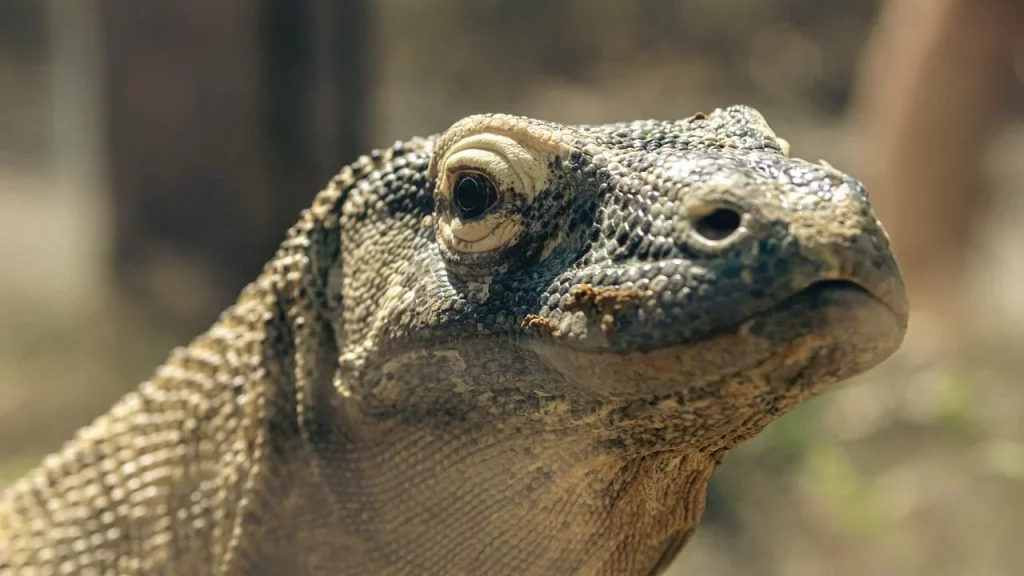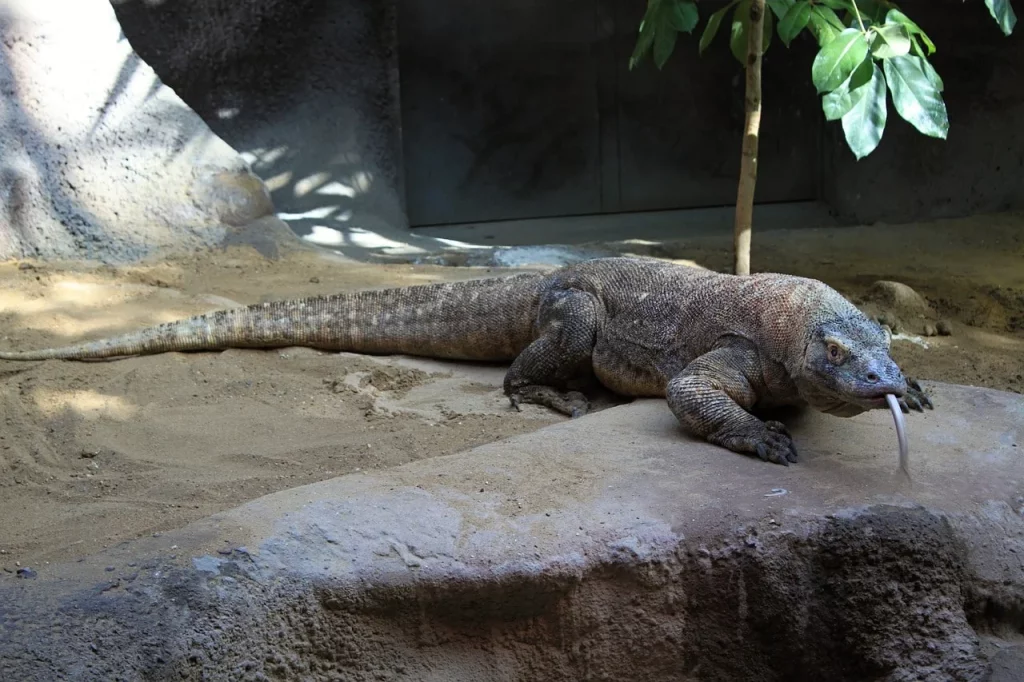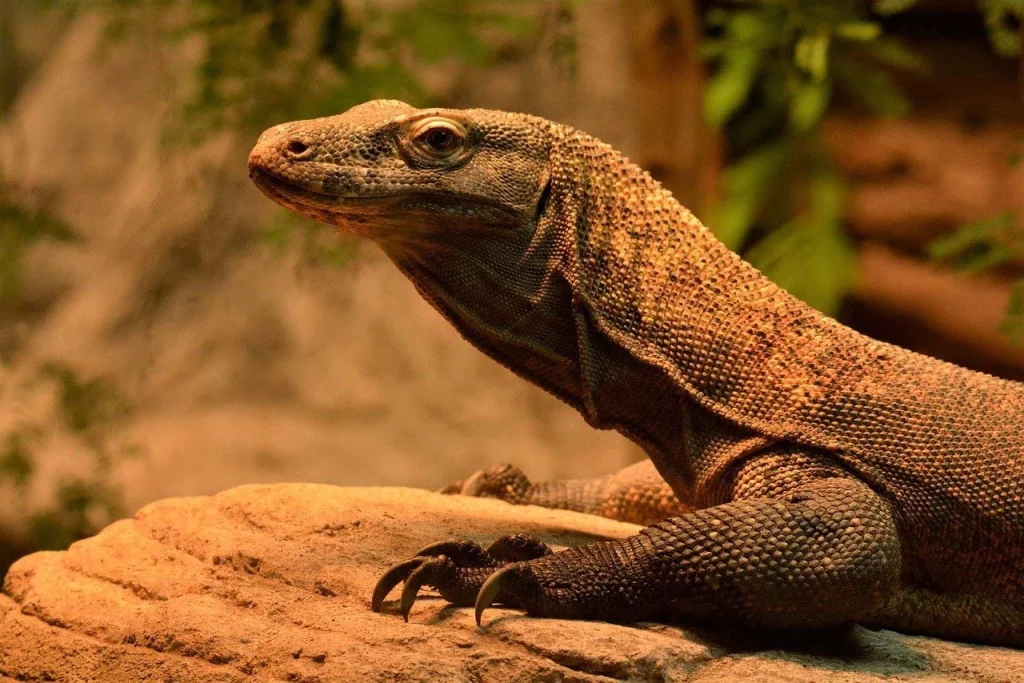Have you ever wondered about the ancient behemoths that roam the Earth, not in the age of dinosaurs, but right now, in our own time? Enter the Komodo dragon, Earth’s largest living lizard, a creature that seems to defy the passage of time itself.
In this journey through some astonishing facts, we will uncover the mysteries and marvels of these magnificent predators. From their venomous bite to their island domains, prepare to be transported into the world of the Komodo dragon, a real-life dragon that walks among us.
The Komodo dragon, a creature almost out of legend, reminds us of the raw beauty of nature.
Sir David Attenborough
Komodo Dragon Facts
Dive into the fascinating world of Komodo dragons before testing your knowledge with our quiz at the article’s end. Read carefully to prove your expertise on these incredible creatures.
- These colossal reptiles can grow over 10 feet in length and tip the scales at over 300 pounds, making them the largest lizards on the planet.
- Equipped with venomous glands, they produce a cocktail of poisons that induce shock, muscle paralysis, and excessive bleeding in their victims.
- Native to Indonesia, their exclusive habitats include the islands of Komodo, Rinca, Flores, Gili Motang, and Padar.
- Capable of devouring 80% of their body weight in one feeding, their eating capacity is astounding.
- In pursuit of prey, they can sprint swiftly at speeds reaching 20 km/h over short distances.
- They boast a long lifespan, with some living up to 30 years in their natural habitats.
- These giants are proficient swimmers, adept at crossing between islands in their geographical range.
- Their olfactory senses are sharp, enabling them to detect carrion nearly 9.5 kilometers away.
- Typically solitary creatures, they gather primarily for mating and feeding.
- They lay up to 20 eggs, which undergo incubation for around 8 months before the hatchlings emerge.
- To evade predators, including cannibalistic adults, juveniles spend their initial years in trees.
- Their dietary preferences are diverse, feasting on invertebrates, birds, and mammals.
- Tool use has been observed, such as utilizing sticks to extract food from crevices.

- Among themselves, they maintain a social hierarchy, particularly visible during communal feasts.
- Their dermal armor consists of scales embedded with tiny bone plates called osteoderms, offering protection against physical harm.
- In the absence of males, they have the unique capability of asexual reproduction via parthenogenesis.
- Over 50 different bacterial strains have been identified in their saliva, previously believed to be the main factor behind their bite’s deadliness.
- They utilize a forked tongue to taste the air, aiding in locating prey.
- Studies have demonstrated their ability to learn and remember, showcasing their cognitive skills.
- They were first discovered by the Western world in 1910, marking their introduction to scientific literature.
- Listed as vulnerable, their existence is threatened by human activity and natural calamities.
- Living in closed island ecosystems makes them particularly susceptible to environmental changes.
- Notably, they can heal from severe injuries quickly, recovering from wounds inflicted during confrontations.
- Uniquely, they can hydrate by absorbing water through their skin, a rare feature among reptiles.
- Local myths and legends often feature them, highlighting their impact on indigenous cultures.
- As apex predators, they play an essential role in the balance of their ecosystems.
- Their size is attributed to island gigantism, a common evolutionary trait among isolated populations.
- Containing potent antibacterial peptides, their blood is of significant interest for biomedical research.

- They are capable of enduring extended periods without food, relying on stored fat reserves for energy.
- Equipped with a hemipenis, they possess a dual-penised reproductive organ, typical among squamates.
- Their defense mechanisms include a formidable display of hissing, throat inflation, and occasional charges.
- Experts in stealth, they wait patiently for the perfect moment to ambush their prey.
- Monitoring their population is critical due to their restricted range and vulnerability to external threats.
- In adulthood, they face no natural enemies, reigning supreme in their food chain.
- Recent studies have clarified misconceptions about their saliva, revealing the complexity of their venom.
- Males often engage in combat over territories and mates, showcasing their territorial instincts.
- They communicate through a variety of signals and vocalizations, facilitating interaction among their kind.
- Climate change is a formidable challenge, impacting their food sources and island habitats.

- A 1926 silent film first brought them to public attention, sparking widespread fascination.
- Genetic studies offer insights into their evolutionary history and adaptability.
- Conservation initiatives focus on habitat preservation, anti-poaching efforts, and ecological research.
- They attract ecotourism, which, while beneficial, requires careful management to prevent adverse effects on their populations.
- Subject to local conservation practices, these have historically aided in their protection.
- They demonstrate agility in climbing trees and rocks, contradicting assumptions about their mobility.
- Representing an example of evolutionary endurance, they have existed for millions of years with little change.
- Their reproductive tactics include both sexual and asexual methods, ensuring survival under various conditions.
- As a symbol of conservation, they underscore the importance of preserving biodiversity.
- They possess acute night vision, aiding in their nocturnal hunting activities.
- Some individuals exhibit albinism, a rare genetic condition resulting in white or pale skin.
- They are known to swallow prey whole, thanks to their flexible jaws and expandable stomachs.
Komodo Dragon Myths

After diving into the interesting facts about Komodo dragons, it’s now time to sift through the myths. Let’s separate fact from fiction as we continue our exploration.
- Komodo Dragons Breathe Fire
Despite their mythical name suggesting a fiery breath, Komodo dragons cannot breathe fire. These reptiles are powerful predators with sharp teeth and a strong bite, employing venom and a group hunting strategy to subdue prey, not fire. - Komodo Dragons Are Slow Creatures
Contrary to the belief that they are sluggish, they can run swiftly for short distances. Speeds of up to 20 kilometers per hour (about 12 miles per hour) have been recorded, showcasing their ability to ambush prey effectively. - Komodo Dragons Are Common Throughout Indonesia
While it is often thought that these dragons roam freely across Indonesia, their habitat is actually quite limited. They are found only in Komodo National Park and a few neighboring islands. Conservation efforts are critical for their survival due to this limited distribution. - Komodo Dragons Are Solitary Animals
Although they were once believed to lead solitary lives, research has shown that they have complex social behaviors. They engage in playful activities and can recognize individual humans and dragons, indicating a level of social interaction not previously attributed to them. - Komodo Dragons Only Eat Large Prey
It’s a common misconception that they exclusively hunt large animals. In reality, their diet is diverse, ranging from birds and small mammals to large water buffaloes. They are opportunistic feeders, adapting their hunting strategy to the available prey sizes.
No products found.
Komodo Dragon Quotes

As the world’s largest lizard, it commands attention with its imposing presence and ancient lineage. Below, you will find some quotes from notable figures about these majestic creatures.
Seeing a Komodo dragon in the wild is like stepping back in time to the age of the dinosaurs.
Steve Irwin
Steve Irwin describes the experience of encountering a Komodo dragon in its natural habitat as a journey back to prehistoric times, highlighting the ancient lineage of these remarkable creatures.
The Komodo dragon is a living reminder of the power and mystery of evolution.
Jane Goodall
Jane Goodall reflects on the Komodo dragon as a testament to the wonders of evolutionary science, underscoring the creature’s significance in understanding natural history.
To look into the eyes of a Komodo dragon is to glimpse the very essence of survival.
Bear Grylls
Bear Grylls speaks to the primal instinct and resilience found within the Komodo dragon, symbolizing the sheer will to survive present in the animal kingdom.
The Komodo dragon: nature’s perfect predator, yet a marvel of the ecosystem.
David Attenborough
David Attenborough again offers insight into the Komodo dragon, this time highlighting its role as an apex predator that is integral to the balance of its ecosystem.
In the presence of a Komodo dragon, one can’t help but feel the ancient pulse of the earth itself.
Sylvia Earle
Sylvia Earle eloquently captures the profound connection between observing a Komodo dragon and feeling a deeper link to the planet’s ancient rhythms and cycles.
Komodo Dragon FAQ

The path from Komodo dragon quotes leads us here, to the threshold of our quiz. The FAQs that follow are pivotal, so read carefully.
- Are Komodo dragons poisonous?
No, they aren’t exactly poisonous. They have venomous glands that produce toxins, which can cause shock, blood loss, and even paralysis in their prey. So, it’s more accurate to say they’re venomous than poisonous. - What do Komodo dragons eat?
They aren’t picky eaters; they enjoy a varied diet. They feast on everything from birds and eggs to large mammals like deer, pigs, and even water buffaloes. They’ve also been known to scavenge for carrion, making them opportunistic feeders. - How fast is a Komodo dragon?
When they need to, they can hustle! They can sprint up to speeds of about 13 mph (20 km/h) in short bursts. This quick speed helps them ambush their prey, despite their heavy, bulky bodies. - How many Komodo dragons are left?
The number of Komodo dragons is sadly decreasing, with estimates suggesting there are only around 6,000 left in the wild. They’re classified as endangered, primarily due to habitat loss, natural disasters, and poaching. - Can a Komodo dragon eat a human?
Yes, though it’s extremely rare, they have been known to attack and even eat humans. These incidents are not common, as humans aren’t their preferred prey, but it’s a reminder of their powerful predatory instincts.
No products found.
Komodo Dragon Trivia

Welcome to the ultimate Komodo dragon quiz, where the only thing fiercer than these giant lizards is the embarrassment you’ll face if you don’t nail at least one question right. Proceed at your own risk!
Conclusion
After finishing our exploration of Komodo dragons, we’re left with an appreciation for these extraordinary reptiles. Their ability to survive in harsh environments, their unique hunting strategies, and their critical role in their ecosystem underscore the wonders of evolution.
Komodo dragons challenge our perceptions of the natural world, reminding us that there are still mysteries to unravel and giants among us. Their continued existence hinges on our actions and commitment to conservation.
So, as we part ways with these incredible beings, let me ask you a funny question: If Komodo dragons could participate in the Olympics, which sport do you think they’d dominate? Let me know in the comments.
2 Sources Used For This Article

